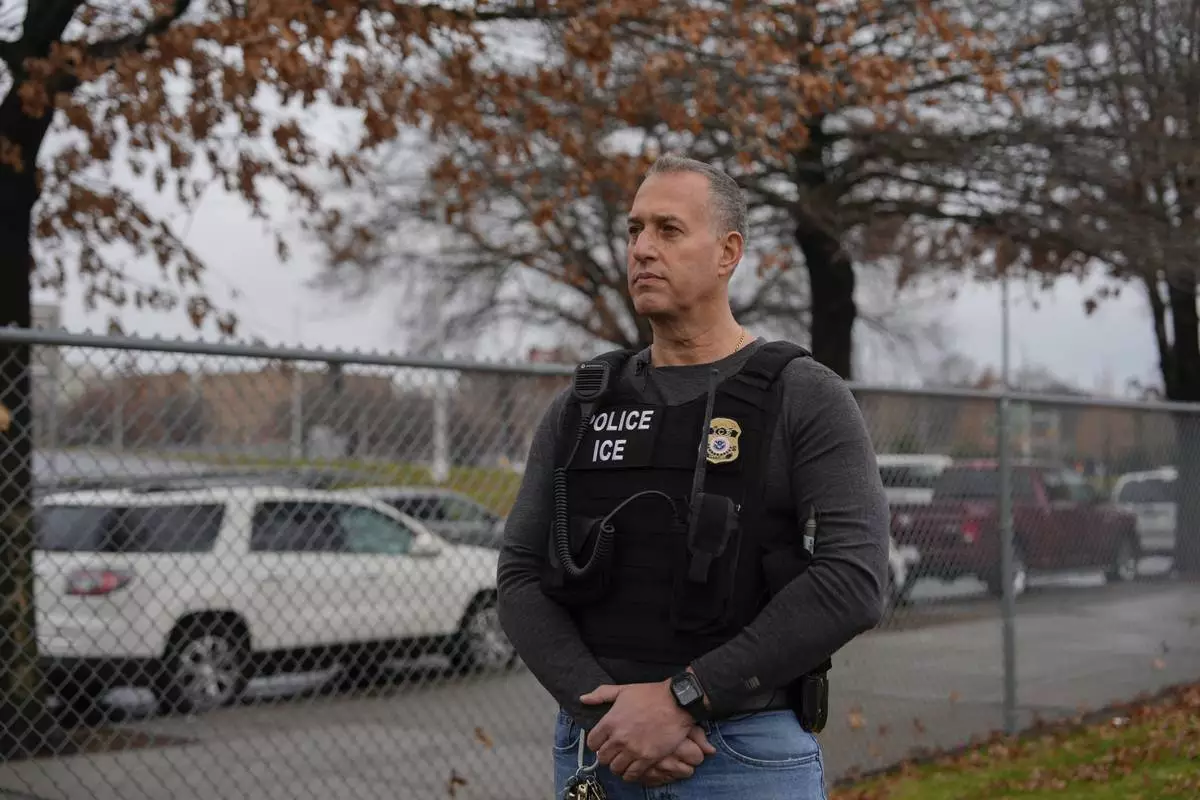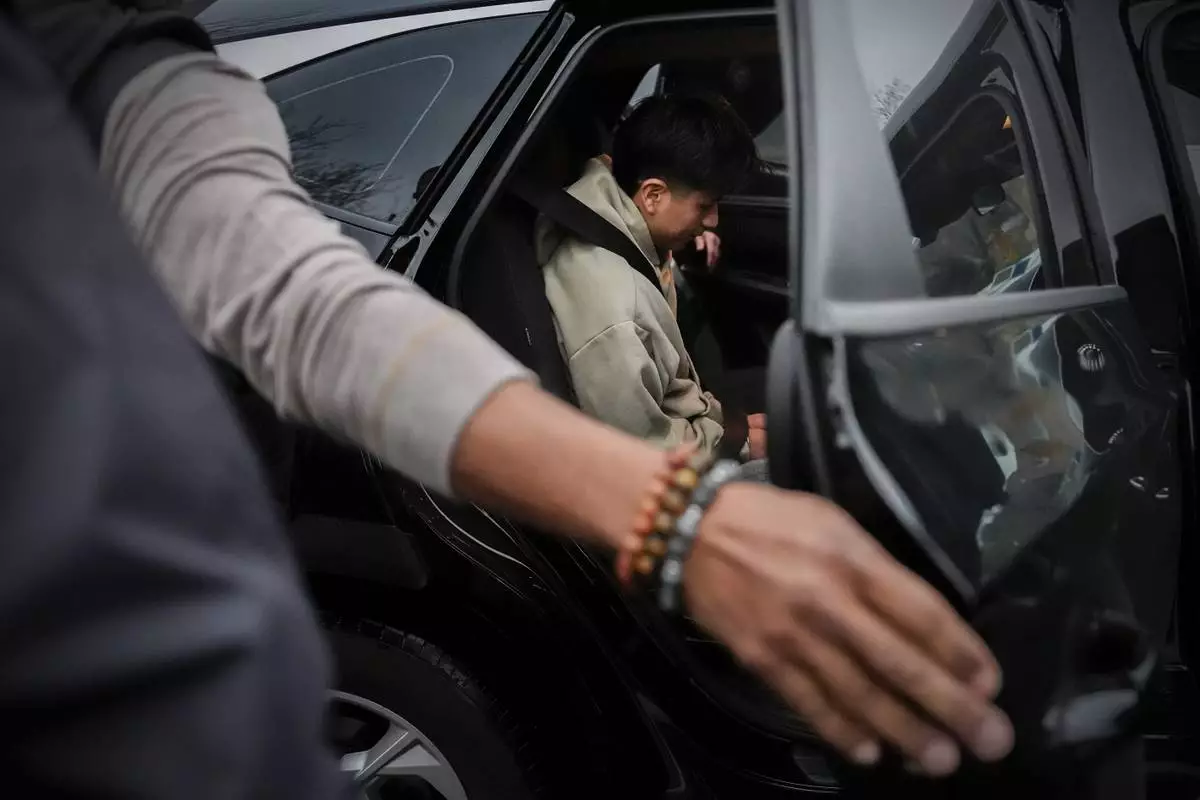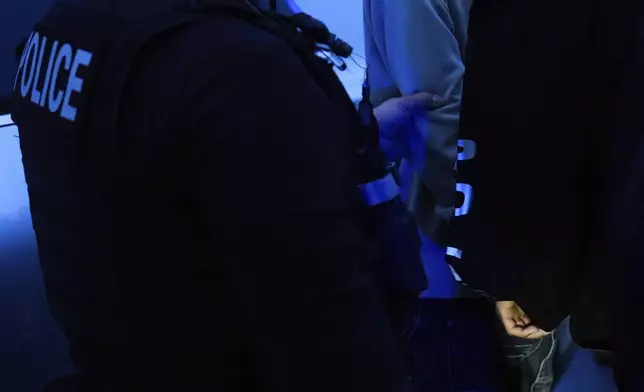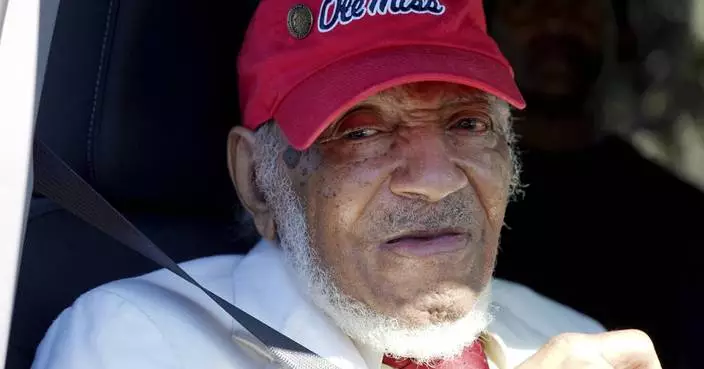NEW YORK (AP) — The immigration officers sat in their vehicles before dawn near a two-story building. A New York subway line rumbled overhead, then an officer's voice crackled over the radio.
After watching for about two hours, he said, “I think that's Tango,” using a term for target. “Gray hoodie. Backpack. Walking quickly.”
The immigration officers surrounded and handcuffed a 23-year-old man from Ecuador who had been convicted of sexually assaulting a minor.
Kenneth Genalo, head of Enforcement and Removal Operations for Immigration and Customs Enforcement in New York, said a popular misconception is that officers can sweep into a community and pick up a wide swath of people who are in the United States illegally and send them to their home countries.
“It’s called targeted enforcement,” Genalo said. “We don’t grab people and then take them to JFK and put them on a plane."
With Donald Trump returning to the White House, there is intense interest in how the Republican will carry out his immigration agenda, including a campaign pledge of mass deportations. His priorities could run into the realities faced by agents focused on enforcement and removals, including the unit in New York that offered The Associated Press a glimpse into its operations: The number of people already on its lists to target eclipses the number of officers available to do the work.
The Biden administration had narrowed deportation priorities to public safety threats and recent border crossers. Trump's incoming “border czar,” Tom Homan, says officials in the new administration also will prioritize those who pose a risk, such as criminals, before moving on to immigrants whom courts have ordered removed from the U.S.
But Homan also has signaled that enforcement could be wider: “If you’re in the country illegally you got a problem,” he said recently on Dr. Phil’s Merit TV.
It's a tall order.
About 1.4 million people have final orders of removal, while about 660,000 under immigration supervision either have been convicted of crimes or are facing charges. But only 6,000 officers within ICE are tasked with monitoring noncitizens in the country and then finding and removing those not eligible to stay.
Those staffing numbers have largely remained static as their caseload has roughly quadrupled over the past decade to 7.6 million. About 10% of that workforce was pulled from their regular duties last year to go to the U.S.-Mexico border at times when immigration spiked.
Jason Houser, ICE chief of staff earlier in the Biden administration, said the number of officers needed to pursue those deemed a public safety threat are at direct odds with the goal of deporting people in large numbers.
“You're not going to be able to do both of those with the resources you have, with the deportation officers you have,” Houser said. “Just the arithmetic, the time-intensive nature of those sort of arrests will overwhelm any ability to get to those large scale numbers.”
Genalo said the officers in charge of individual cases have to get a lead, ensure they have the legal authority to arrest someone and then track the person down. They generally aren't allowed to enter a residence, so they want to catch people outside.
On this recent operation, about a dozen officers gathered before 5 a.m. at a White Castle parking lot in the Bronx. After putting on their body armor and checking their equipment, they circled around for a briefing.
Besides the 23-year-old Ecuadorian man, they were going after a 36-year-old Mexican man convicted of forcibly touching a young girl and another Ecuadorian also convicted of sexual abuse of a minor.
The first target, the 23-year-old man, who pleaded guilty to raping a 14-year-old girl, was believed to usually leave the apartment building around 7 a.m. or 7:30 a.m. Sometimes he was with a woman and child.
“Light came on in the first floor of the apartment,” an officer waiting outside said over the radio. Then later: “Someone came out of the basement, but it’s not our target.”
They finally spotted him, swept him into the back of a vehicle and quickly left the neighborhood.
Inside, the man's 22-year-old wife didn't know what had happened until he called later from detention.
In an interview, she said they met in Ecuador and had a child — a bubbly 3-year-old girl with braids — and she was pregnant with their second. He worked construction while she was a manicurist.
She said she knew why her husband had been arrested but felt there were important mitigating factors. She said they knew it was possible her husband could be sent back to Ecuador after his criminal case wrapped up but that it was still a shock.
ICE deported more than 270,000 people over a recent 12-month period, the highest annual tally in a decade, the agency said in a recent report. But it also said it made fewer arrests of noncitizens, in part because of the demand of sending staff to the border. Of those arrested, a greater proportion had serious criminal histories.
Some cities and states work with ICE to turn over people in their custody who aren't U.S. citizens.
But many left-leaning states and cities have so-called sanctuary policies that limit cooperation with federal immigration authorities. In New York City, for example, ICE used to have an office at the jail to easily take custody of noncitizens. In 2014, then-Mayor Bill de Blasio signed legislation kicking out ICE and restricting police cooperation.
His successor, Eric Adams, has shown willingness to revisit some of those policies. He recently met with Homan and told reporters they agreed on pursuing people who commit violent crimes.
Genalo said agents spend time and resources picking up immigrants few would argue should have the right to stay in America.
“How can you state that sanctuary policies help the community when you’re releasing all these criminals right back into the community?” he said. “We’re safer when we collaborate.”
Staffing is also an issue. He said he's supposed to have about 325 officers, but in recent years, the number has been about 30% lower.
Many immigration advocates have long-standing concerns about ICE's tactics, and those concerns are deepening with Trump's return to office in January.
Advocates say the incoming administration's position of going after public safety threats is already longtime policy. They object to rhetoric they say paints immigrants as people to be feared. They say there can be nuances in some cases: Maybe someone committed a crime a long time ago and has been rehabilitated, or someone facing a final order of removal moved and never got the notice.
During Trump's first term, there were a lot of “collateral arrests” where immigration officers would detain others besides those being targeted, said Jehan Laner, a senior staff attorney for the Immigrant Legal Resource Center. That destabilizes communities, she said, adding, “We saw them go after everyone.”
Genalo said he couldn’t comment on the incoming administration’s plans but stressed that officers are going after specific targets with criminal histories. He said he has a docket of about 58,000 people who either have criminal convictions or pending charges.
“I’m pretty sure we’re going to be tied up for a while dealing with the criminal population," Genalo said.
Associated Press reporter Cedar Attanasio contributed to this report.

Kenneth Genalo, director of U.S. Immigration and Customs Enforcement's New York City field office, looks at the apartment of Wilmer Patricio Medina-Medina during an early morning operation, Tuesday, Dec. 17, 2024, in the Bronx borough of New York. (AP Photo/Julia Demaree Nikhinson)

Deportation officers with Enforcement and Removal Operations in U.S. Immigration and Customs Enforcement's New York City field office arrest Wilmer Patricio Medina-Medina during an early morning operation, Tuesday, Dec. 17, 2024, in the Bronx borough of New York. (AP Photo/Julia Demaree Nikhinson)

Deportation officers with Enforcement and Removal Operations in U.S. Immigration and Customs Enforcement's New York City field office arrest Wilmer Patricio Medina-Medina during an early morning operation, Tuesday, Dec. 17, 2024, in the Bronx borough of New York. (AP Photo/Julia Demaree Nikhinson)

Deportation officers with Enforcement and Removal Operations in U.S. Immigration and Customs Enforcement's New York City field office arrest Wilmer Patricio Medina-Medina during an early morning operation, Tuesday, Dec. 17, 2024, in the Bronx borough of New York. (AP Photo/Julia Demaree Nikhinson)

A deportation officer with Enforcement and Removal Operations in U.S. Immigration and Customs Enforcement's New York City field office carries the backpack of Wilmer Patricio Medina-Medina after arresting him during an early morning operation, Tuesday, Dec. 17, 2024, in the Bronx borough of New York. (AP Photo/Julia Demaree Nikhinson)

Enforcement and Removal Operations deportation officers with U.S. Immigration and Customs Enforcement's New York City field office conduct a brief before an early morning operation, Tuesday, Dec. 17, 2024, in the Bronx borough of New York. (AP Photo/Julia Demaree Nikhinson)

Kenneth Genalo, director of U.S. Immigration and Customs Enforcement's New York City field office, holds an information sheet on Wilmer Patricio Medina-Medina during an early morning operation, Tuesday, Dec. 17, 2024, in the Bronx borough of New York. (AP Photo/Julia Demaree Nikhinson)

Kenneth Genalo, director of U.S. Immigration and Customs Enforcement's New York City field office, speaks during an interview with The Associated Press, Tuesday, Dec. 17, 2024, in the Bronx borough of New York. (AP Photo/Julia Demaree Nikhinson)

A deportation officer with Enforcement and Removal Operations in U.S. Immigration and Customs Enforcement's New York City field office conducts a brief before an early morning operation, Tuesday, Dec. 17, 2024, in the Bronx borough of New York. (AP Photo/Julia Demaree Nikhinson)

Kenneth Genalo, director of U.S. Immigration and Customs Enforcement's New York City field office, looks at the apartment of Wilmer Patricio Medina-Medina during an early morning operation, Tuesday, Dec. 17, 2024, in the Bronx borough of New York. (AP Photo/Julia Demaree Nikhinson)

Deportation officers with Enforcement and Removal Operations in U.S. Immigration and Customs Enforcement's New York City field office arrest Wilmer Patricio Medina-Medina during an early morning operation, Tuesday, Dec. 17, 2024, in the Bronx borough of New York. (AP Photo/Julia Demaree Nikhinson)

A deportation officer with Enforcement and Removal Operations in U.S. Immigration and Customs Enforcement's New York City field office, left, walks to arrest Wilmer Patricio Medina-Medina, right, during an early morning operation, Tuesday, Dec. 17, 2024, in the Bronx borough of New York. (AP Photo/Julia Demaree Nikhinson)

Deportation officers with Enforcement and Removal Operations in U.S. Immigration and Customs Enforcement's New York City field office arrest Wilmer Patricio Medina-Medina during an early morning operation, Tuesday, Dec. 17, 2024, in the Bronx borough of New York. (AP Photo/Julia Demaree Nikhinson)

A chain depicting St. Michael, the patron saint of law enforcement, hangs from the rear view mirror of Kenneth Genalo's, director of U.S. Immigration and Customs Enforcement's New York City field office, car during an early morning operation, Tuesday, Dec. 17, 2024, in the Bronx borough of New York. (AP Photo/Julia Demaree Nikhinson)

A deportation officer with Enforcement and Removal Operations in U.S. Immigration and Customs Enforcement's New York City field office changes the handcuffs of Wilmer Patricio Medina-Medina from back to front after arresting him during an early morning operation, Tuesday, Dec. 17, 2024, in the Bronx borough of New York. (AP Photo/Julia Demaree Nikhinson)

Judith Almodovar, deputy director for U.S. Immigration and Customs Enforcement's New York City field office, listens to a brief before an early morning operation, Tuesday, Dec. 17, 2024, in the Bronx borough of New York. (AP Photo/Julia Demaree Nikhinson)

Kenneth Genalo, director of U.S. Immigration and Customs Enforcement's New York City field office, listens to his radio during an early morning operation, Tuesday, Dec. 17, 2024, in the Bronx borough of New York. (AP Photo/Julia Demaree Nikhinson)

Kenneth Genalo, director of U.S. Immigration and Customs Enforcement's New York City field office, speaks during an interview with The Associated Press, Tuesday, Dec. 17, 2024, in the Bronx borough of New York. (AP Photo/Julia Demaree Nikhinson)

A deportation officer with Enforcement and Removal Operations in U.S. Immigration and Customs Enforcement's New York City field office puts Wilmer Patricio Medina-Medina in the back of a car after arresting him during an early morning operation, Tuesday, Dec. 17, 2024, in the Bronx borough of New York. (AP Photo/Julia Demaree Nikhinson)

A deportation officer with Enforcement and Removal Operations in U.S. Immigration and Customs Enforcement's New York City field office changes the handcuffs of Wilmer Patricio Medina-Medina from back to front after arresting him during an early morning operation, Tuesday, Dec. 17, 2024, in the Bronx borough of New York. (AP Photo/Julia Demaree Nikhinson)






























